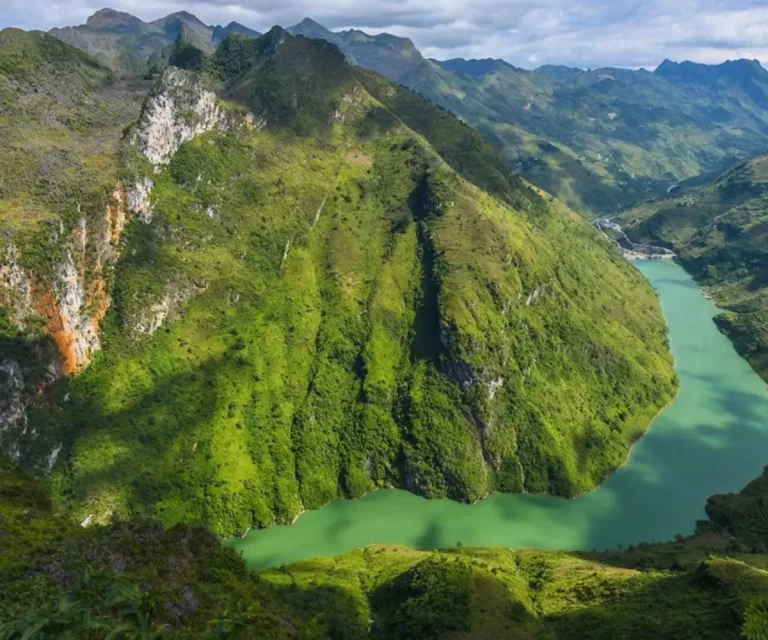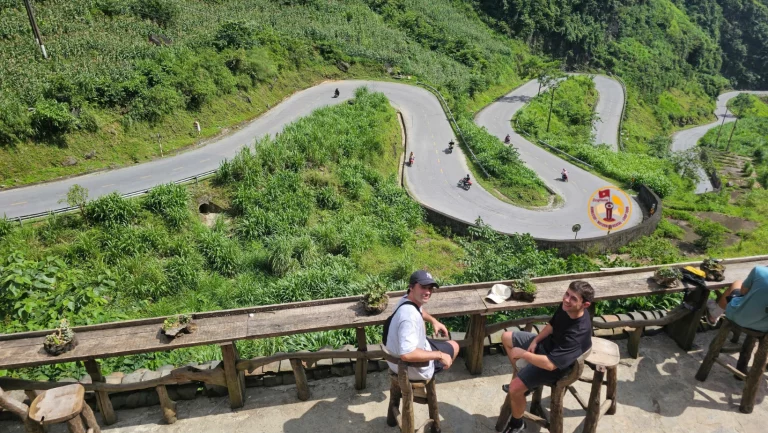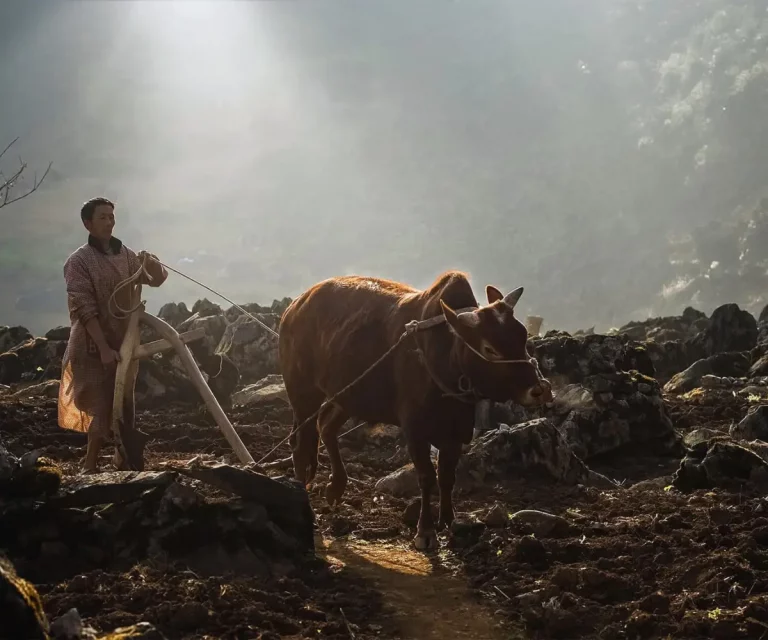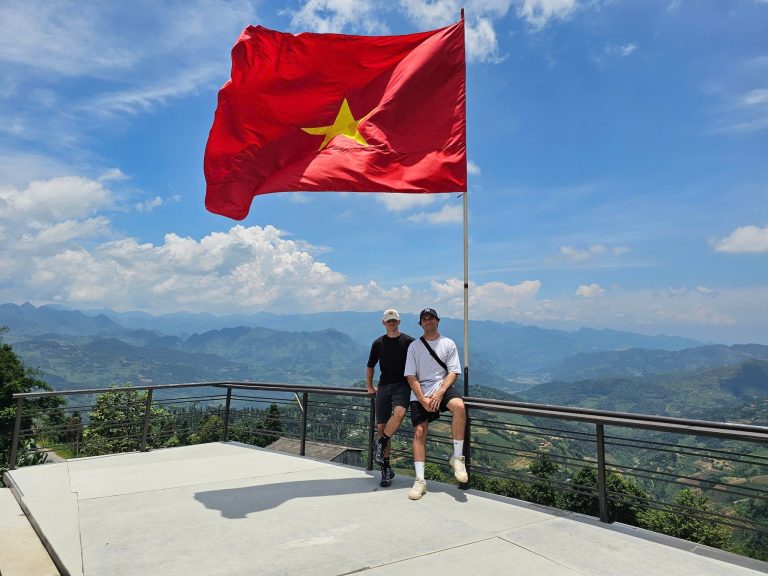Dong Van Geopark travel guide: Discover the heart of Ha Giang’s highlands
homestayhagiang
Dong Van Geopark, nestled in the northernmost reaches of Vietnam, is a breathtaking fusion of natural beauty and cultural heritage that leaves visitors spellbound. Its dramatic limestone landscapes, shaped by over 500 million years of geological evolution, create a spectacle that captivates both travelers and geologists. This UNESCO Global Geopark not only features towering peaks, deep gorges, and rich biodiversity but also serves as a vibrant mosaic of cultures, with 17 ethnic minority groups calling it home. If you yearn for a destination that offers thrilling adventures alongside authentic cultural experiences, Dong Van Geopark is calling your name.
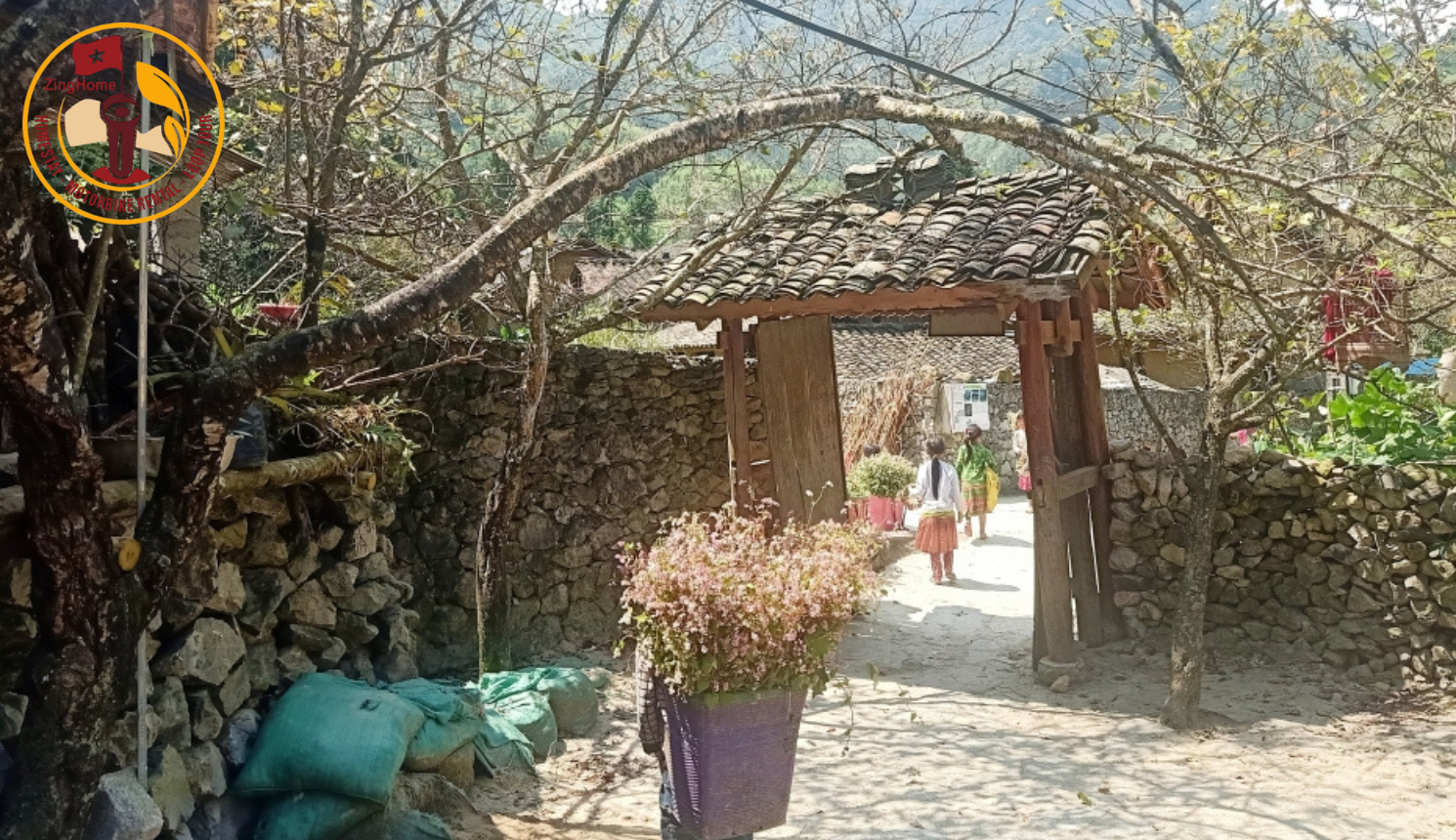
Local life in the heart of Dong Van Geopark
What to know about Dong Van Geopark
Dong Van Geopark stands as a shining example of Vietnam’s ability to blend stunning natural landscapes with rich cultural narratives. Covering an area of over 2,356 square kilometers, this UNESCO Global Geopark captures the essence of Vietnam’s geological history while celebrating the colorful traditions of its people. The combination of impressive limestone formations and vibrant ethnic communities creates an immersive experience that attracts visitors year-round.
From outdoor adventures and cultural exploration to a culinary journey that tantalizes the senses, dong van geopark offers something for everyone. As we delve deeper, we’ll explore its unique characteristics, top reasons to visit, and essential travel tips to make your trip truly unforgettable.
What is Dong Van Geopark?
Dong Van Geopark is more than just a scenic destination; it is a living canvas shaped by nature and culture. Located in Ha Giang province, this geopark is famous for its dramatic limestone formations and surreal landscapes that have earned global recognition.
- Geological Significance: Spanning over 500 million years of Earth’s history, dong van geopark showcases diverse sedimentary rocks, fossils, and striking karst features like hills, valleys, and caves—making it a treasure trove for geology enthusiasts.
- Biodiversity: The area is a biodiversity hotspot, home to many endemic plant and animal species. Each ecosystem here offers a unique experience for nature lovers.
- Cultural Mosaic: Inhabited by 17 ethnic minority groups, the geopark reflects a rich cultural tapestry. Visitors can explore traditional festivals, crafts, and local lifestyles that make the region so vibrant.
- Culinary Diversity: The highland cuisine, built on local ingredients and farming traditions, offers unique flavors that reflect the area’s cultural identity.
With its rich geology, diverse ecosystems, and deep-rooted culture, dong van geopark promises a travel experience that’s both meaningful and memorable.
Why should you visit Dong Van?
Looking for compelling reasons to add dong van geopark to your travel itinerary? Here are a few highlights that might spark your interest:
- Stunning Landscape: The dramatic limestone mountains, lush valleys, and iconic formations create unforgettable scenery. Places like Ma Pi Leng Pass offer breathtaking panoramic views.
- Adventure Activities: From trekking and rock climbing to kayaking on the Nho Que River, dong van geopark is a haven for outdoor enthusiasts seeking adventure in a rugged and scenic setting.
- Cultural Immersion: Join local festivals, visit ethnic markets, or stay in traditional homestays to gain authentic insights into the lives of the region’s ethnic communities.
- Historical Insights: Discover historical landmarks such as the Hmong King’s Palace and Lung Cu Flag Tower, which offer a deeper understanding of the area’s rich cultural and historical heritage.
- Culinary Delights: Savor traditional highland dishes made from fresh, local ingredients. The unique flavors reflect the culinary traditions passed down through generations.
Whether you’re an adventurer, culture lover, or foodie, dong van geopark offers experiences that are as diverse as they are unforgettable.
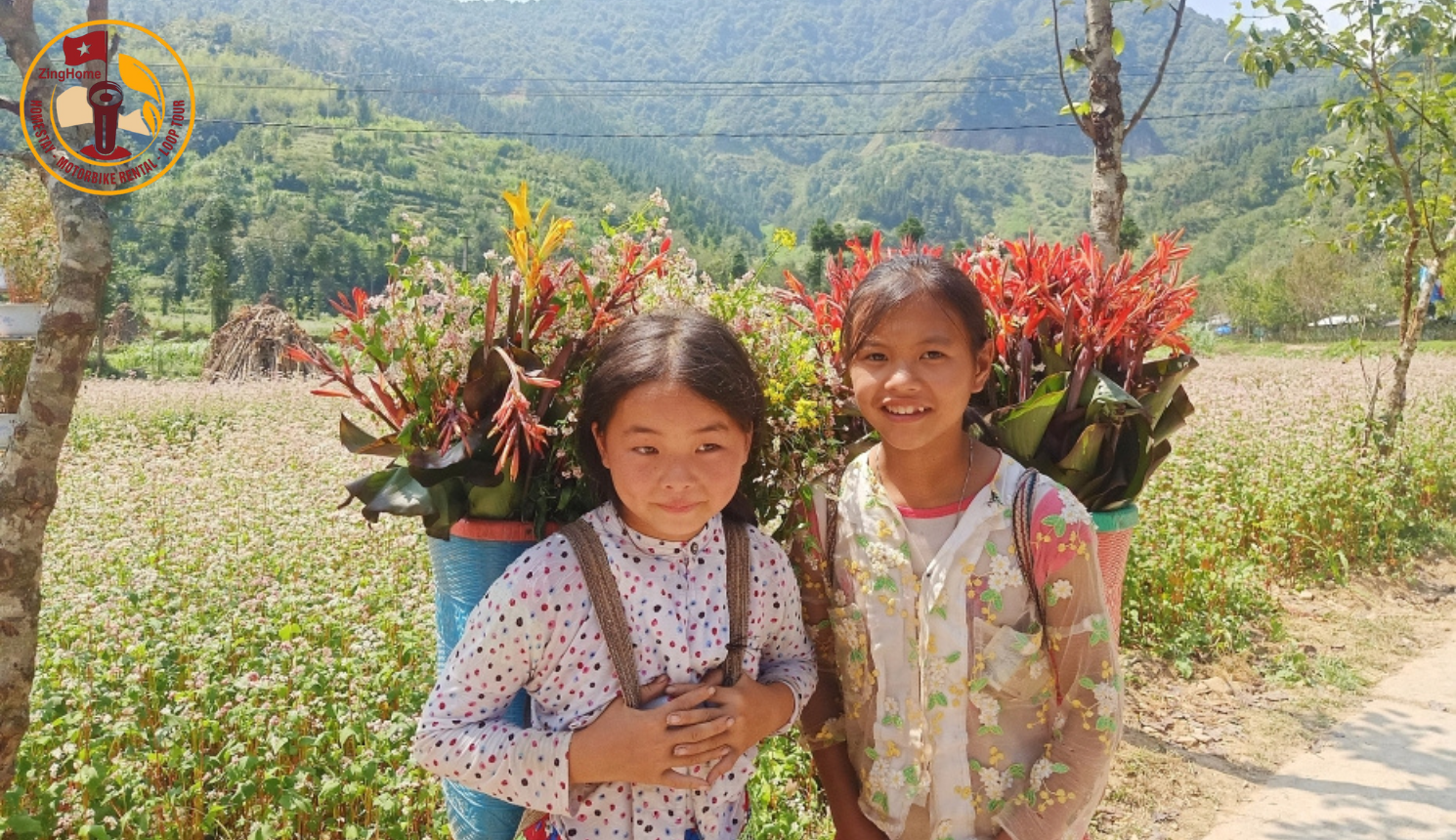
Buckwheat flower fields in full bloom at Dong Van Geopark
Best time to visit
Timing is key when planning your journey to Dong Van geopark. Each season offers distinct experiences that resonate with different types of travelers. Here’s a quick guide to help you choose the best time to visit:
- September to November: This is buckwheat flower season, when the fields bloom in shades of white and purple, offering stunning views for photographers. It’s also rice harvest time, turning the terraced fields into golden landscapes.
- December to February: Winter brings a cool, foggy atmosphere that adds a mystical feel to the mountains. It’s a peaceful time for quiet hikes and reflection.
- March to May: Spring brings blooming peach and plum trees, along with vibrant local festivals. It’s a great time to enjoy the mild weather and engage with local cultural events.
- June to August: Though the rainy season, the landscape is lush and green. Nature lovers may appreciate the vibrant scenery, but travelers should be aware of occasional heavy rain and reduced visibility.
By planning your trip around these seasonal highlights, you’ll make the most of your experience in Dong Van geopark.
How to get to Dong Van
Visiting Dong Van geopark involves a bit of travel planning, considering the distance from major urban centers. The journey not only leads you to a stunning destination but also embodies the adventure spirit of travel. Here’s how you can easily reach this stunning geopark.
From Hanoi to Ha Giang
The journey to Dong Van geopark typically begins in Hanoi, Vietnam’s capital. Located about 300 kilometers from Ha Giang — the gateway to the geopark — travelers have several transportation options to choose from:
- By Bus: This is the most popular option. Buses from Hanoi to Ha Giang City take around 6–7 hours. Ticket prices range from 250,000 to 350,000 VND (approximately $10–15). Overnight buses are ideal for saving time and arriving early.
- By Motorbike: For those seeking adventure, renting a motorbike in Hanoi offers flexibility and scenic views along the route. Travel time varies from 6 to 8 hours, depending on your pace and rest stops.
- Private Car Hire: Hiring a private car with a driver provides comfort and convenience, especially for families or groups. It allows you to travel at your own pace and enjoy the beautiful mountain roads along the way.
Once you arrive in Ha Giang, you’re just a step away from the natural and cultural wonders of Dong Van geopark.
From Ha Giang city to Dong Van
Once you arrive in Ha Giang, the journey to Dong Van Geopark continues with a scenic 140-kilometer route to Dong Van town. Here are a few transportation options to consider:
- Local Bus: Local buses operate on this route, though less frequently. The trip takes about 3–4 hours, with tickets typically priced around 100,000 VND. It’s recommended to check the schedule in advance.
- Motorbike Rental: Renting a motorbike in Ha Giang is a popular choice among travelers who want the freedom to explore. The ride takes roughly 3–4 hours, with opportunities to stop and enjoy the mountain views and visit ethnic villages along the way.
- Private Car or Taxi: Hiring a private car offers comfort and convenience, especially for groups or those traveling with luggage. You’ll also have more flexibility to stop for sightseeing.
Whichever option you choose, the route to Dong Van Geopark is part of the experience—filled with winding mountain roads, scenic vistas, and glimpses of local life.
Suggested transportation: Motorbike, sleeper bus, private car
Traveling within the enchanting landscapes of Dong Van Geopark requires the right mode of transport to match your preferences and sense of adventure. Here are some recommended ways to get around the plateau and its surrounding attractions:
- Motorbike: A favorite among adventurous travelers, motorbiking offers flexibility to explore at your own pace. The rugged terrain and winding roads provide access to remote villages and scenic viewpoints. Rental costs range from 200,000 to 400,000 VND per day. Be sure to factor in fuel and insurance.
- Sleeper Bus: For covering longer distances in comfort, sleeper buses are a convenient option. Operating mainly at night, they allow you to rest and arrive ready to explore. Prices typically range from 240,000 to 300,000 VND.
- Private Car Hire: Ideal for families or groups, hiring a private car provides comfort and full control over your itinerary. While more expensive—starting at around 1,500,000 VND—it offers the flexibility to stop at notable sights along the way.
Choosing the right transportation can greatly enhance your experience in Dong Van Geopark, helping you make the most of your journey through its stunning mountain landscapes and rich cultural sites.
Top attractions in Dong Van
Having traversed the paths leading to Dong Van, you’ll now want to explore the top attractions that make this area unique. Listing a variety of cultural and natural landmarks is essential for experiencing the full spectrum of what Dong Van Geopark offers.
Lung Cu flag tower – The cacred northernmost point
One of the must-visit landmarks within Dong Van Geopark is the Lung Cu Flag Tower, marking the northernmost point of Vietnam. Standing over 1,400 meters above sea level, this iconic structure symbolizes national sovereignty and pride. Visitors can climb 839 stone steps to reach the top and enjoy sweeping views of mountains, valleys, and even glimpses of the China–Vietnam border.
The tower’s 54-square-meter flag represents Vietnam’s 54 ethnic groups, serving as a powerful emblem of unity and identity. This makes Lung Cu a meaningful stop for both domestic and international travelers interested in the country’s heritage.
The journey to Lung Cu is equally rewarding, with scenic routes passing terraced rice fields and traditional villages. Nearby, communities like Lo Lo Chai offer immersive cultural experiences, where visitors can engage with local customs and daily life.
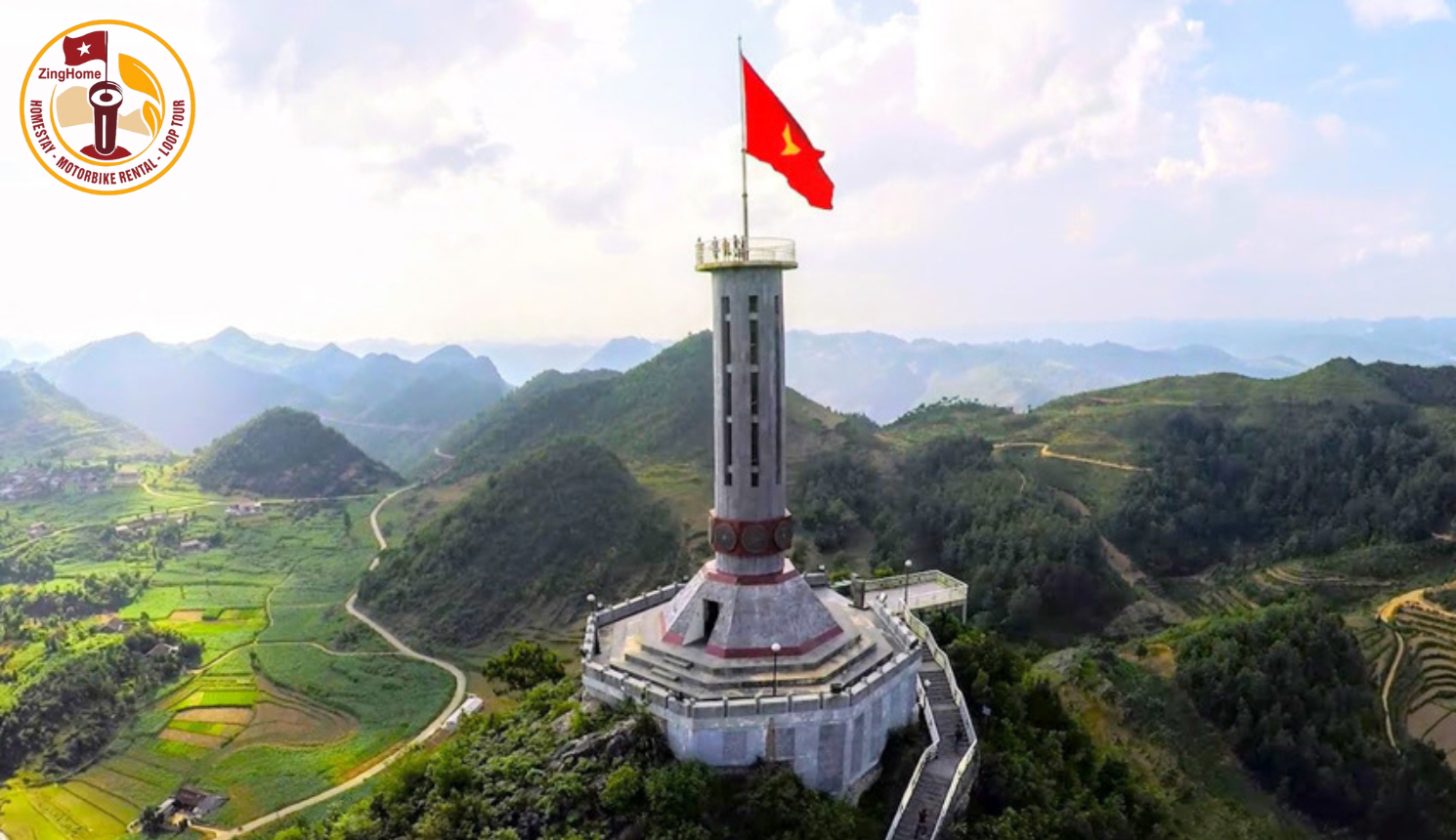
The Vietnamese Flag Flies High at Lung Cu Peak
Hmong King’s Palace – unique Hmong architecture
Built between 1898 and 1903, the Hmong King’s Palace (Dinh Vua Mèo) is a striking example of traditional Hmong architecture within Dong Van Geopark. Located in Sa Phin Valley, the palace blends indigenous design with Chinese influences, seen in its thick earthen walls and intricately carved wooden beams.
The complex includes 64 rooms, reflecting the exceptional craftsmanship of the time. Originally built as a royal residence for Hmong King Vuong Chinh Duc and his descendants, it now serves as a living museum, offering insights into Hmong culture and royal heritage.
Nearby, the Dong Van Old Quarter is another must-visit attraction. Known for its cobblestone streets and traditional houses, the area hosts vibrant markets and offers a glimpse into the everyday lives of local ethnic communities.
Both the Hmong King’s Palace and Dong Van Old Quarter are essential stops for anyone eager to explore the rich history, culture, and architecture that define Dong Van Geopark.
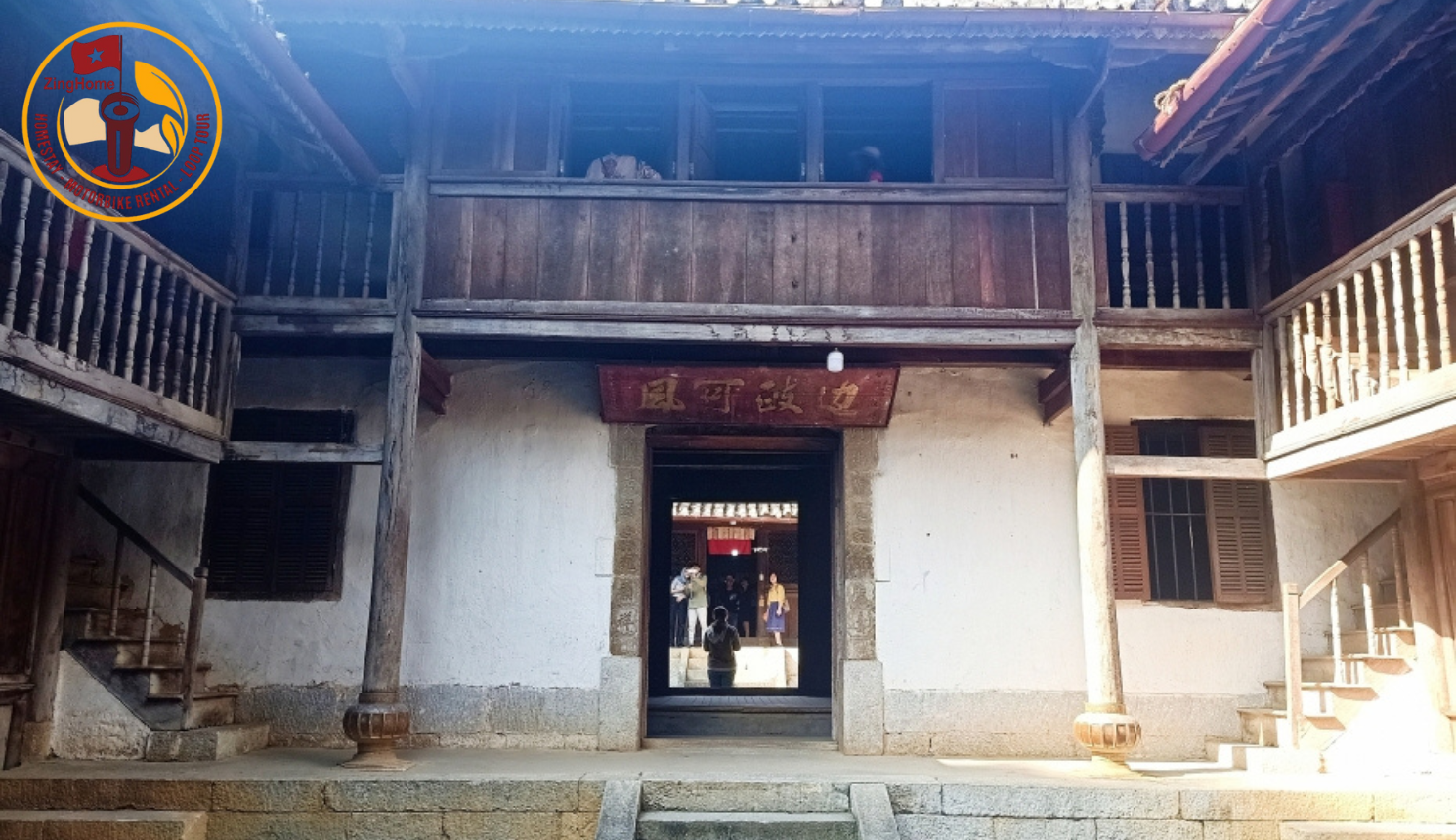
The Mysterious Beauty of the H’Mong King’s Palace
Dong Van Old Quarter – ancient charm in the heart of stone
The Dong Van Old Quarter, with its cobblestone streets and timeworn architecture, offers a charming window into the region’s rich history. Located within Dong Van Geopark, this cultural landmark features well-preserved buildings that reflect the traditional architectural styles of the Hmong and other ethnic minorities who have lived here for generations.
Strolling through the Old Quarter feels like stepping back in time. Narrow alleys lined with wooden houses and small storefronts lead visitors past bustling markets filled with colorful textiles, handmade crafts, and fresh local produce. It’s a place where travelers can connect with local artisans and witness daily life unfold.
As night falls, the Old Quarter transforms into a lively hub. The streets light up with laughter, music, and the aroma of traditional dishes served at small eateries. This vibrant atmosphere, combined with the warmth of the local people, makes the Old Quarter one of the most memorable experiences in Dong Van Geopark.
Must-try tourist activities
As you explore the wonders of Dong Van, engaging in a variety of activities will enrich your experience and allow you to better connect with the local culture and natural environment.
Trekking and scenic hiking
One of the top activities in Dong Van Geopark is trekking through its spectacular landscapes. The limestone mountains and lush valleys provide diverse trails suitable for all skill levels. Popular routes often lead to iconic viewpoints like Ma Pi Leng Pass, offering panoramic vistas that attract both hikers and photographers.
Trekking paths also pass through remote ethnic villages, where visitors can engage with local communities and gain meaningful insights into traditional customs. From learning local crafts to tasting authentic dishes and observing daily agricultural life, the cultural immersion adds depth to every journey.
For adventure seekers, Dong Van Geopark also offers rock climbing and kayaking on the stunning Nho Que River. These activities bring travelers even closer to the natural environment and elevate the sense of exploration.
With its breathtaking scenery and rich cultural connections, trekking in Dong Van Geopark promises an unforgettable experience for nature lovers and cultural explorers alike.
Flower season check-in: Buckwheat blossoms, rice terraces
The arrival of fall transforms Dong Van Geopark into a breathtaking tapestry of color, best experienced during the buckwheat flower season from September to December. The peak months of October and November bring vibrant shades of white, pink, and purple, making the landscape especially appealing to photographers and nature lovers.
One standout destination is Sung La Village, renowned for its stunning buckwheat flower fields. Visitors can wander through picturesque terraces and admire the vibrant contrast of golden rice fields during harvest season.
Set against the dramatic backdrop of Dong Van’s limestone formations, this time of year is perfect for leisurely hikes and capturing unforgettable photos. Local markets also come alive, offering buckwheat-based delicacies, handmade crafts, and traditional festivals that celebrate the season.
Experiencing Dong Van Geopark during the flower season offers a sensory journey filled with color, culture, and lasting memories.
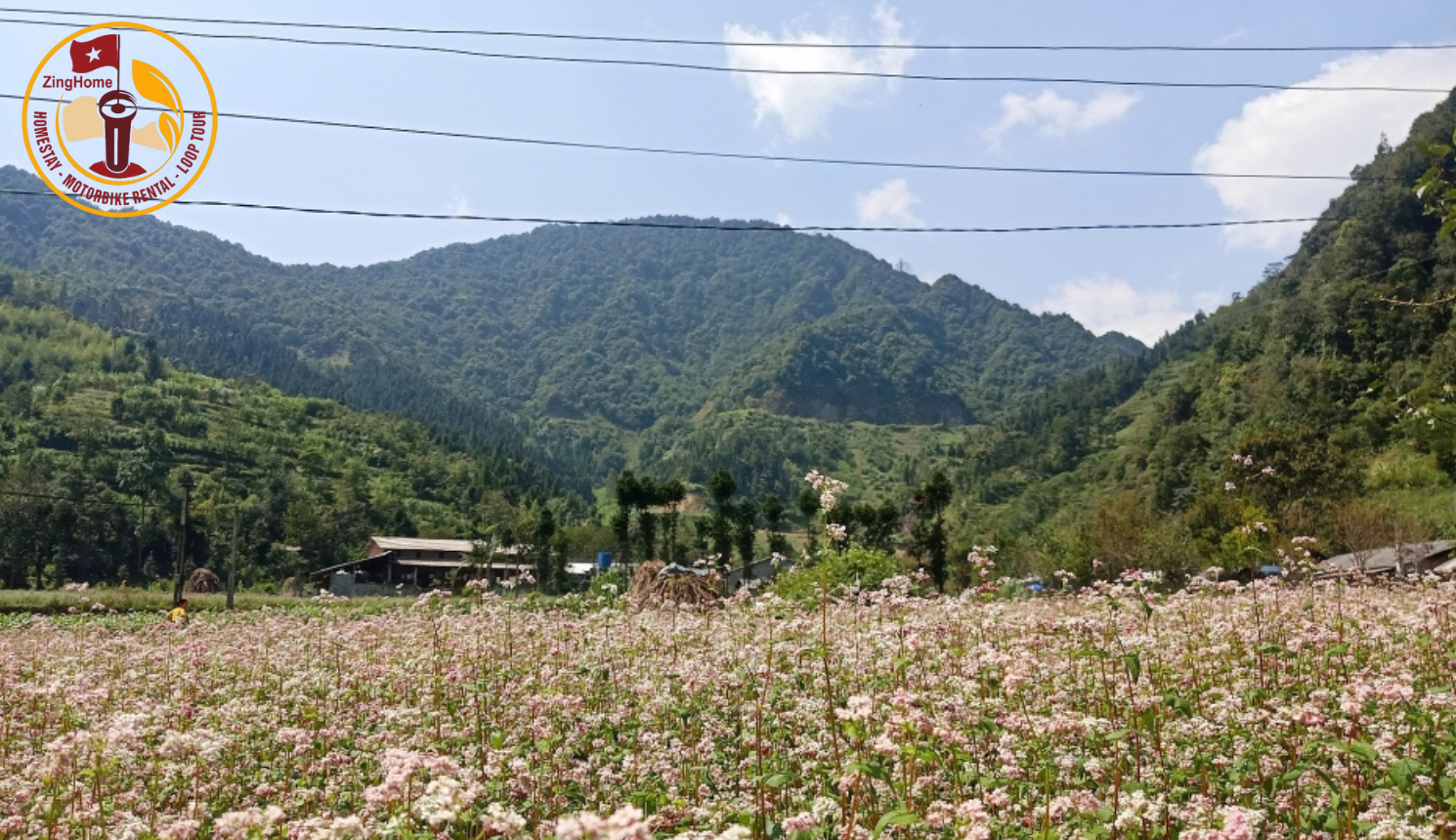
A Sea of Buckwheat Flowers Under the Mountain Sky
Explore local markets and traditional festivals
Exploring local markets is an integral part of immersing oneself in the culture of Dong Van Geopark. Various villages host vibrant markets each week, particularly on Sundays, where ethnic minorities come together to sell goods, barter, and socialize.
Stay with locals in Cozy Homestays
Staying with local families in cozy homestays offers visitors a meaningful way to connect with the vibrant communities of Dong Van Geopark. Many homestays are built in traditional Hmong style, often featuring wooden interiors and stunning views of surrounding mountains and terraced rice fields.
Guests can take part in daily activities like cooking traditional dishes or helping with rice planting and harvesting. These moments provide authentic insights into local life and foster genuine bonds between visitors and hosts.
- Cultural Exchange: Many homestays promote interactive experiences where guests can learn the stories and customs of local ethnic groups.
- Home-Cooked Meals: Meals prepared by host families feature fresh, seasonal ingredients and showcase the rich culinary traditions of the region.
- Community Engagement: Choosing a homestay helps support local households and contributes to sustainable tourism in Dong Van Geopark.
More than just a place to sleep, homestays in Dong Van offer immersive cultural encounters and warm hospitality—making every traveler feel like part of the family.
Unique highland cuisine
Food is an essential part of the travel experience in Dong Van, offering a fantastic opportunity to explore the culinary heritage of Vietnam’s northern highlands. Each dish tells a story, drawing upon local ingredients and cultural traditions, reflecting the heart of the people.
Local dishes: Thang Co (Horse heat Stew), buckwheat cakes, men men (steamed cornmeal), black chicken hotpot
Each dish in Dong Van Geopark carries its own unique flavor, reflecting the region’s highland culture and agricultural heritage. Local cuisine not only satisfies the palate but also offers a deeper connection to the lives and traditions of ethnic communities.
- Thang Co: A traditional dish made from horse meat, often simmered in a large pot with aromatic spices. Rich and hearty, Thang Co is typically enjoyed during festivals and community gatherings, symbolizing both cultural pride and social unity.
- Buckwheat Cakes: Crafted from buckwheat flour, these rustic cakes are a specialty of the region, especially during flower season. They’re often served with savory sides and reflect the importance of buckwheat farming in local life.
- Men Men: A simple yet essential dish, Men Men is made from steamed cornmeal and commonly paired with meat or Thang Co. It highlights the role of corn as a dietary staple in the highlands.
- Black Chicken Hotpot: Known for its distinct flavor and nutritional value, this dish offers a warm, communal dining experience. Families and friends gather around a simmering pot to cook and share ingredients together.
To truly savor the flavors of Dong Van Geopark, visitors should explore local markets and eateries, where these dishes are prepared with authenticity and heart—adding another layer to the cultural richness of the region.
Recommended eateries in Dong Van
When exploring the culinary landscape of Dong Van Geopark, several eateries offer authentic dining experiences that highlight the region’s rich food culture. Here are some recommended spots to enjoy local flavors:
- Local Markets: On market days, vendors serve fresh portions of Thang Co and other regional dishes. It’s a great way to taste local specialties while interacting with friendly residents.
- Lung Cam Cultural Village Restaurant: Set against a scenic backdrop, this restaurant features traditional decor and serves popular dishes made with fresh, local ingredients—offering both great views and great flavor.
- Bui Homestay: More than just a place to stay, Bui Homestay provides home-cooked meals and even cooking classes, allowing guests to dive deeper into the culinary traditions of Dong Van Geopark.
- Dong Van Market Vendors: A highlight for food lovers, the market is filled with stalls offering everything from buckwheat cakes to grilled meats, creating an immersive and delicious experience.
These dining spots not only satisfy your taste buds but also connect you with the cultural heart of Dong Van Geopark—making food an unforgettable part of your journey.
Where to stay in Dong Van
Finding comfortable accommodations is essential to enjoying your visit to Dong Van. The area offers a range of options, from traditional homestays to modern hotels, catering to different preferences and budgets.
Highlighted friendly homestays
Choosing a homestay is not only a great way to immerse yourself in local culture, but also a chance to support families within Dong Van Geopark. Here are some popular and friendly homestays that offer warm hospitality and enriching experiences:
- Nha Co Homestay 1925: Situated in the heart of Dong Van Old Quarter, this historic homestay showcases over 200 years of Hmong architecture. Prices range from $10 to $15 per night, with opportunities to experience traditional customs in an authentic setting.
- Bui Homestay: Known for its relaxed, communal atmosphere, this two-story homestay is perfect for adventurous travelers. Rates start around $15, offering both comfort and cultural connection.
- Ma Le Homestay: Located in a traditional house in Ma Le Village, this homestay emphasizes cultural exchange. Guests can join rice field walks and participate in local activities. Prices typically range from $15 to $20.
- Dong Van Hmong Homestay: Immersed in the heart of a Hmong community, this homestay allows guests to engage in village life and enjoy hands-on experiences. Rates are about $14 per night.
Staying at these homestays in Dong Van Geopark offers more than just accommodation—it’s a doorway to cultural understanding, personal connection, and unforgettable memories.
Suggested hotels and guesthouses
Visitors to Dong Van Geopark can choose from a wide range of hotels and guesthouses, offering various levels of comfort, amenities, and cultural charm. Whether you prefer a traditional setting or modern convenience, there’s something for every traveler.
- Dong Van Golden Hotel: Located at the foot of Lung Cu Mountain, this modern hotel provides panoramic views and full services, including motorbike rentals. Prices range from 150,000 to 2,500,000 VND.
- Old House Homestay: With its traditional Hmong architecture, this rustic stay offers a cozy atmosphere at affordable rates between 100,000 and 200,000 VND per night.
- Bui Homestay: Situated near the Dong Van welcome gate, this homestay features a warm wooden design. Double room rates range from 400,000 to 500,000 VND.
- Plum Homestay: Famous for its bird’s nest–inspired design and sweeping mountain views, this homestay starts at 600,000 VND per night.
- Homie Homestay: Offering views of the Lung Cu Flag Tower, wooden interiors, and a local vibe, room rates vary from 110,000 to 1,210,000 VND.
Choosing the right accommodation not only ensures comfort but also enhances your experience in Dong Van Geopark—connecting you more deeply with the natural beauty and rich heritage of this remarkable destination.
Tips for booking during peak seasons
Travelers aiming to visit Dong Van during peak seasons should keep certain tips in mind for a smooth and enjoyable stay.
- Advance Reservations: Given the rising popularity of Dong Van, particularly from March to May, booking accommodations well in advance is crucial to securing your preferred lodging.
- Read Guest Reviews: When selecting where to stay, prioritizing places with positive reviews can provide insights into service quality and comfort.
- Flexible Cancellation Policies: Opting for accommodations with free cancellation policies can be wise, allowing flexibility if travel plans unexpectedly change.
- Direct Communication: Sometimes, directly contacting accommodation providers can yield better rates or additional insights regarding local events and attractions.
- Check Local Listings: Utilizing platforms like Booking.com or Airbnb can help you find diverse options while comparing prices and amenities that suit your needs.
By adhering to these tips, securing your accommodation becomes less stressful, ensuring you can focus on enjoying your time in the enchanting Dong Van.
Travel tips and useful information
Preparing for a trip to Dong Van requires thoughtful planning to optimize your experience in this highland region. Here are some essential travel tips and information to consider.
What to pack & how to prepare for highland travel
Proper packing plays a vital role in ensuring a smooth and enjoyable journey through Dong Van Geopark. Here’s a quick guide to help you prepare:
- Clothing: Layered outfits are recommended to handle the region’s temperature shifts between day and night. Lightweight clothes work well for daytime, while a warm jacket is essential for cooler evenings. A waterproof layer is useful during unexpected rain.
- Footwear: A durable pair of hiking shoes is ideal for exploring rugged trails. Consider bringing sandals for comfort during downtime at your accommodation.
- Personal Items: Sunscreen, sunglasses, and a wide-brimmed hat protect against sun exposure. Insect repellent is also recommended due to the natural environment.
- Health Kit: A basic first aid kit with essential medications is important, as pharmacies may be limited in remote areas.
- Camping Gear: If you plan to camp, don’t forget a tent, sleeping bag, and compact cooking equipment.
With the right preparation, your adventure in Dong Van Geopark will be both comfortable and rewarding—allowing you to fully enjoy its stunning landscapes and rich cultural heritage.
Environmental and cultural preservation rules
When visiting Dong Van Geopark, it’s essential to practice responsible tourism to help preserve its natural landscapes and cultural heritage. Here are some key guidelines to follow:
- Respect Local Culture: Engage with ethnic communities respectfully by learning about their customs and traditions. Support local artisans and participate in cultural workshops to experience authenticity while contributing to cultural preservation.
- Use Eco-Friendly Transport: Choose to walk or cycle when exploring Dong Van Geopark. This reduces your environmental footprint and allows for a deeper, more personal connection with the surroundings.
- Follow Designated Trails: Staying on marked hiking paths helps prevent erosion and protects the delicate karst landscape, ensuring its beauty is preserved for future visitors.
- Limit Waste: Bring reusable bottles and bags to reduce plastic usage. Always take your trash with you to maintain a clean and welcoming environment.
- Participate in Local Activities: Opt for tours led by local guides to gain valuable insights into the region’s ecological and cultural significance while supporting the local economy.
By adopting sustainable travel habits, visitors play an important role in protecting Dong Van Geopark—ensuring its timeless beauty and cultural depth remain intact for generations to come.
Suggested itineraries for exploring Dong Van
When planning your adventure, it’s helpful to have a structured itinerary in mind to maximize your experience in Dong Van Geopark. Here’s a twp-day itinerary that highlights key attractions:
2-Day-1-Night itinerar
Day 1: Ha Giang – Meo Vac – Dong Van
Begin your journey at 7:30 AM from Ha Giang City. The first stop is Quan Ba Heaven Gate, where you can enjoy marvelous panoramic views. Continue to Meo Vac, making a lunch stop along the way. The highlight of Day 1 is trekking through Ma Pi Leng Pass, offering awe-inspiring vistas overlooking the Nho Que River and its terraced fields. Arrive in Dong Van and settle into your accommodations for the night, tasting local dishes for dinner.
Day 2: Dong Van – Yen Minh – Ha Giang
On your second day, consider an early morning stroll to the Dong Van traditional market if you’re traveling on a Sunday. After breakfast, visit the Vuong Palace, the former residence of the Hmong King. Then head to Yen Minh for a lunch break while enjoying picturesque terraced fields. Return to Ha Giang City in the afternoon, reflecting on your journey immersed in captivating natural beauty and local culture.
This itinerary not only showcases the breathtaking beauty of the Ha Giang Loop but also immerses travelers in the unique cultural heritage of the region. This 2-day-1-night tour offers an exciting and memorable experience you won’t forget.
Combine with the famous Ha Giang loop tour
For those seeking a more extended adventure, the Ha Giang Loop is a perfect complement to visiting Dong Van. This scenic route offers a stunning journey through the region’s mountainous terrain and vibrant ethnic communities.
The loop meanders through various picturesque towns like Meo Vac, Yen Minh, and Quan Ba, showcasing breathtaking landscapes and opportunities to engage with local cultures. The Ha Giang Loop can be typically completed in 3-4 days, giving travelers ample time to explore and soak in the scenery.
By combining your Dong Van visit with the Ha Giang Loop, you’ll uncover the full majesty of Vietnam’s northern highlands, creating memories that last a lifetime.
ZingHome Ha Giang – A reliable travel company specializing in authentic tours across Ha Giang
ZingHome Ha Giang is a trusted tour operator, specializing in providing unique and memorable travel experiences in the stunning Dong Van Karst Plateau of Ha Giang. With a team of passionate, experienced guides who deeply understand the culture and history of the local ethnic minorities, ZingHome is committed to delivering a truly immersive journey through the majestic natural beauty and rich cultural heritage of Ha Giang.
From navigating winding mountain passes like the renowned Ma Pi Leng Pass to visiting remote Hmong and Lo Lo villages nestled deep within the rugged mountains, ZingHome takes you through breathtaking landscapes—where every turn reveals a picture-perfect view. Guests also have the chance to participate in vibrant local festivals, such as the Khau Vai Love Market or the Buckwheat Flower Festival, gaining deeper insight into the traditions and customs of the local people.

Zinghome Ha Giang stands out for its quality service and positive feedback from guests
ZingHome’s services go beyond simply guiding you to the region’s top attractions. They aim to create a complete experience—from staying in warm and welcoming homestays, savoring highland specialties like Thang Co and five-colored sticky rice, to meaningful interactions with local residents that give travelers a true sense of mountain life.
Let ZingHome Ha Giang be your companion on this unforgettable journey through one of Vietnam’s most enchanting and culturally rich destinations.
In conclusion, Dong Van Geopark stands as a powerful testament to nature’s creativity and cultural richness. With its dramatic limestone landscapes, vibrant ethnic communities, and distinct highland cuisine, it offers a truly one-of-a-kind experience for both adventure seekers and culture enthusiasts.
As you journey through this remarkable region, let the towering mountains, welcoming locals, and authentic flavors of Dong Van awaken your senses. From trekking along scenic mountain passes to participating in age-old traditions, every moment spent here becomes a lasting memory.
By embracing the charm and respecting the environment, travelers can enjoy an enriching experience while contributing to the preservation of Dong Van Geopark—a true gem in northern Vietnam that continues to inspire all who visit.















